Akron needs plan for nearly 2 million square feet of downtown buildings
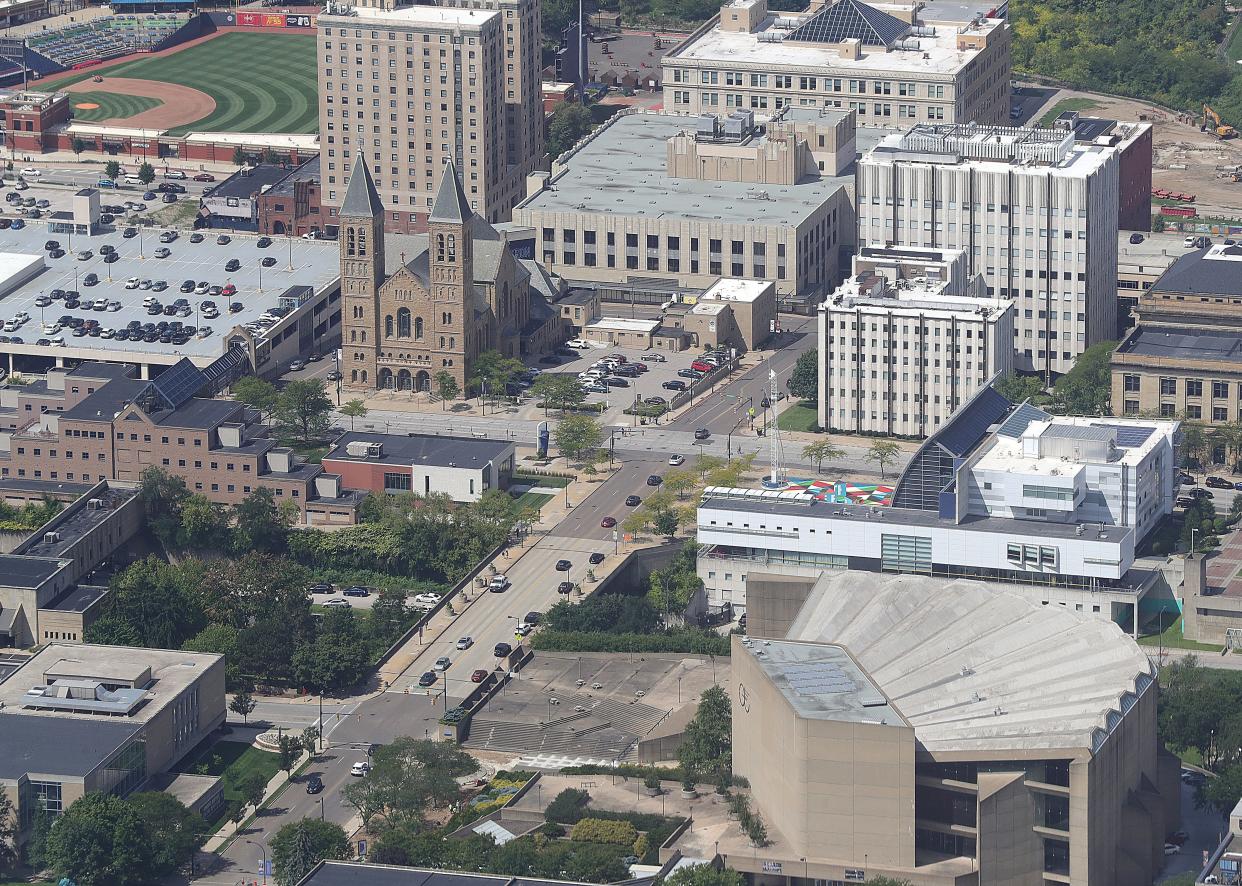
The five tallest buildings in Downtown Akron are either vacant, barely half full or soon-to-be entirely empty.
When FirstEnergy empties its headquarters on Main Street, where 90% of assigned employees work remotely, the Beacon Journal estimates that eight buildings will hold close to 2 million square feet of empty space for lease or redevelopment — most of it former office space.
CBRE, a global firm that researches commercial real estate, reported 30-year high vacancy rates in American office buildings this year, a national trend driven by the biggest buildings quickly outliving their original purpose.
That’s the case for Akron's shuttered hotels and factories, towering office buildings and even a former newspaper building. As work-from-home habits persist, city officials have accepted that the pandemic “decimated the office market.” Builders are scrambling “to save downtown,” as one major developer put it.
The office occupancy rate in Akron is 84.7%, slightly better than the national average but down from 85.7% last year, CBRE reported.
But occupancy rates don't tell the whole story. Tenants on multi-year leases are aggressively subleasing office space or left with more of it to fill. From 2020 to 2023 for all of Akron, CBRE reported a 20-fold increase in the square footage of available sublease space from 23,967 to 515,583.
CBRE 2023 Akron Office report by dhlivingston on Scribd
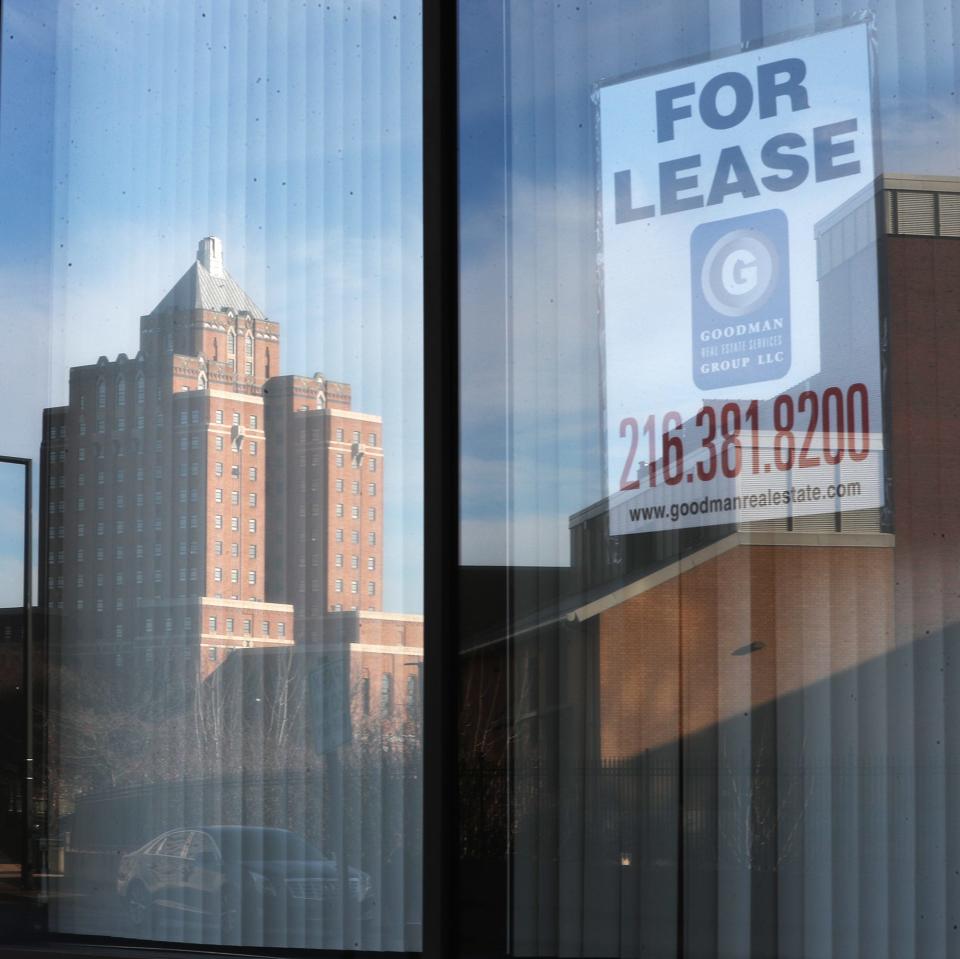
Akron has been here before. A half century ago as rubber mills closed and suburban sprawl sucked the commerce out of downtown, urban renewal projects bulldozed downtown businesses to build Cascade Plaza. The city block and nearby properties are now ground zero for vacant offices and empty hotels.
“All downtowns have a history of a building that’s being used for something and things change,” said Downtown Akron Partnership President and CEO Suzie Graham. “A business goes out. A business leaves. You're built for one purpose and then you have to find another purpose.
“It's part of our history. It's also part of our path forward – to constantly be pushing ourselves to reinvent who we are.”
As the city rolled out new and aggressive tax breaks for residential construction, downtown developers lined up apartment projects. The thinking then was that young professionals would sign leases and companies would follow the workers back downtown.

But companies are unloading, not shopping for, square footage. Developers and city officials now see the new apartments, and more of them, as the means to save struggling retailers, to fill stubbornly empty storefronts and to create a "visiting economy" of tourist and entertainment attractions that have helped other cities recover more quickly from the pandemic.
“If we can capitalize on the empty office space to bring people downtown then you can justify having the storefronts filled,” said developer Joel Testa, “because it's tough for those retail-facing businesses right now, given the lack of foot traffic downtown.”

Testa, who's put a pin in the project, was planning a new hotel and shopping area across the canal from Lock 3, where he leases luxury apartments in Canal Square Lofts. But nobody was building hotels during the pandemic. And consumer-driven foot-traffic just hasn’t returned.
Doubling down on apartments
Market research five years ago called for more apartments downtown even before the shift to remote work walloped demand for office space. Today, apartments are still leasing fast despite an unprecedented level of recent development.
Developers like Tony Troppe have added new studios and lofts in commercial buildings. Three buildings reopened since 2021 – The Landmark, The Goodrich and 159 Main in the former Law Building – offer 340 new apartments and sometimes waiting lists to get in them.
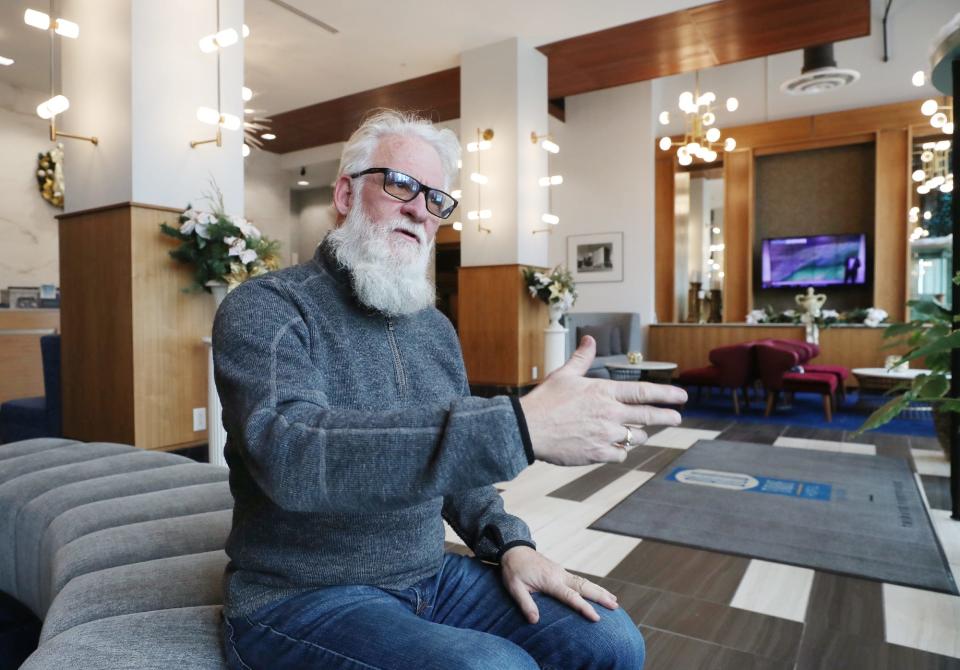
“We're still bullish on downtown, and that's why we're moving forward as fast as we can on CitiCentre,” Don Taylor, president and CEO of Welty Building Company, said of reviving the plan for apartments in the old YWCA Building.
Mayor Dan Horrigan removed nearly all municipal staff from the city-owned building five years ago to let Cleveland developer Ed Asher pursue historic tax credits. The plan, which failed despite an announcement to start construction, included 95 apartments and offices the city no longer needed.
Taylor is at 117 apartments on the new floor plan and looking to fit in a couple more now that the plan is 100% residential.
“I think part of the future to save downtown is going to be to create life down there with residential units and people living, working and playing in that environment,” said Taylor, who had to reapply for the tax credits and, if awarded, hopes to start construction by July.
Taylor led the Bowery Project, where new apartments in the Landmark Building are at capacity. But street-level storefronts in the rest of the five Main Street buildings on the project are mostly empty.
More apartments and people in them could end what Taylor called the “draught” of finding small businesses to lease storefronts.
Lower rents, tenants wanted for commercial properties
Tom Weise, vice president of finance for the Schipper Group, oversees commercial leasing of the AES Building on the south end of downtown.
At less than $19 on average per square foot, Weise said the cost of renting office space in Akron compares well with the $30 or $40 per square foot in larger markets like New York, Chicago and Los Angeles.
But $20 per square foot is still significantly more than nothing.
“At the end of the day,” Weise said, “when you compare that lower occupancy cost (in Akron) against the cost to have employees work from home, that's still an economic comparison that probably tilts towards the work from home model – if you could find a way to make it work effectively and maintain accountability with your employees.”
As developers face rising interest rates and more costly materials, Weise noted that their commercial tenants are are also fighting inflation, forcing them to cut costs by right-sizing.
Leases ending, smaller deals struck
Companies are letting multi-year commercial leases expire or renegotiating them to fit shrinking footprints. Some are taking the opportunity with a surplus of office space to move into higher quality office space.
This problem of commercial tenants needing less space is an opportunity for developers to reinvent lower quality office buildings with declining demand while improving profit margins by limiting supply in the overall market.
“That helps anybody that wants to create really good office space,” said Taylor, “because you got a supply and demand equation that's positive. And some of these bad office buildings actually make really good apartments.”
Taylor, Graham and others pointed to Huntington Tower, which has been on the market since 2019, as a great example of a slender, old office building that’s well suited for apartments. Hotels make great apartments and condos, too, the developers said, because of existing plumbing for bathrooms or kitchens and the ease of modifying floor plans by simply knocking door-sized holes in walls.
Office buildings that lack the extensive plumbing, windows and courtyards that let in the light make terrible apartments, the developers said.
The model for reimagining office space
The impact of the pandemic is on the fourth floor of the AES Building – a shining example, developers said, of how Akron last reinvented itself.
AES stands for Advanced Elastomer Systems, a short-lived business venture between ExxonMobil and Monsanto that occupied the old BF Goodrich tire plant when it was spared the wrecking ball and redeveloped as office space.
Today, at a staggering 457,000 square feet in seven floors (compared to 424,000 square feet in 15 floors at the FirstEnergy Building a mile away), AES is the largest Class A office building in downtown Akron with 22 tenants that include the Greater Akron Chamber of Commerce, Brouse McDowell and the Akron Beacon Journal.
Ten tenants have signed new leases during the pandemic – almost all of them for 10,000 square feet or less. The building has more tenants than before the pandemic but about the same square footage under lease.
A tech-heavy insurance company renegotiated its 54,000-square-foot lease down to 17,000 square feet. Weise landed a new tenant, a financial firm, to refill 30,000 square feet of the empty space.
“I think that was the only large transaction that was probably done in that 2020-21 period," said Weise.
In 2021, attorney John Rasnick died. The law firm carrying his name gave back some of its space on the fourth floor, leaving a vacancy for the Schipper Group to fill.
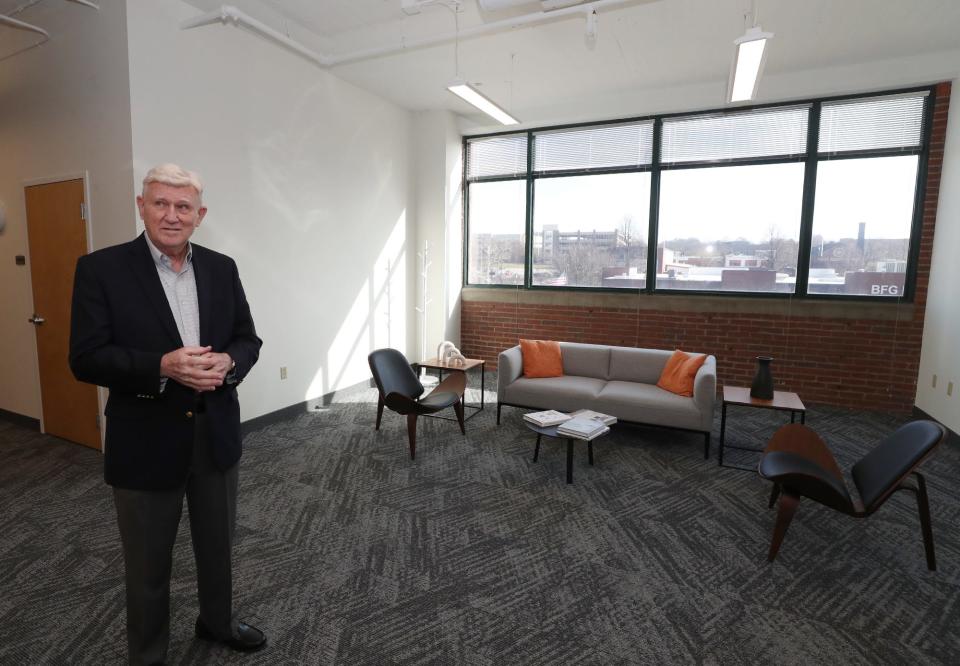
President and CEO David Schipper's brother-in-law spearheaded the redevelopment of the AES Building more than 20 years ago. In Independence — at one of nearly 4,000 locations managed worldwide by IWG, a workplace solutions company — Schipper observed tenants renting office space on-demand monthly for as little as $150 for co-working space and $633 per office.
Schipper and Weise got to work dividing open space on the fourth floor into 30 locked-door offices with a shared conference room, waiting area, cafeteria and sunlit gathering spaces.
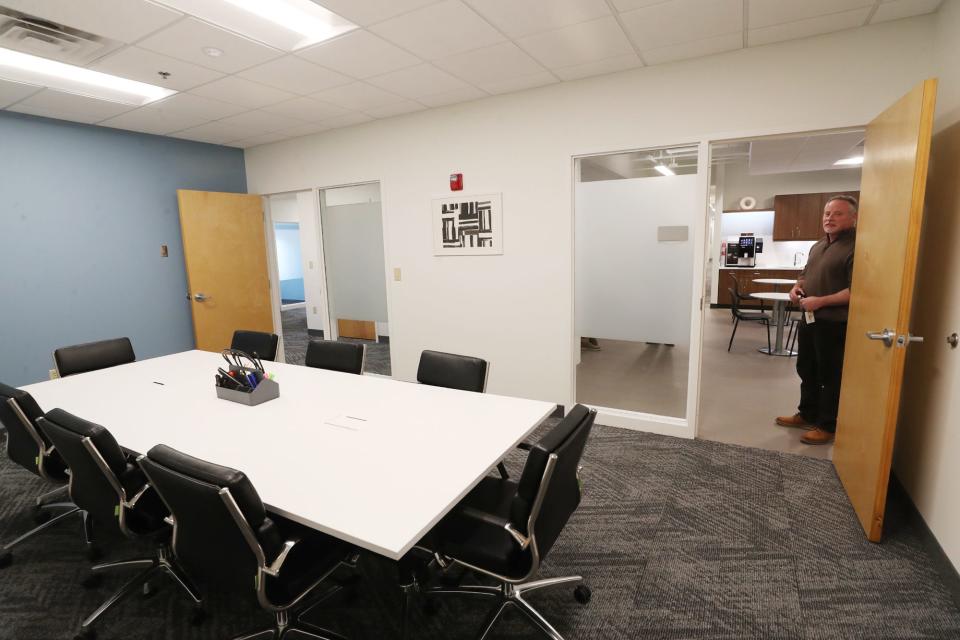
Before the work was done in April and HQ by Regus opened this year, two-thirds of the units were already under lease. Only three units were still available on the last day of November as Schipper rapped his hand on the wall of a hallway long enough to carve out nine more offices.
Tips and comments regarding this story can be emailed to bjnews@thebeaconjournal.com.
This article originally appeared on Akron Beacon Journal: Akron developers discuss plans for empty hotel and office buildings

